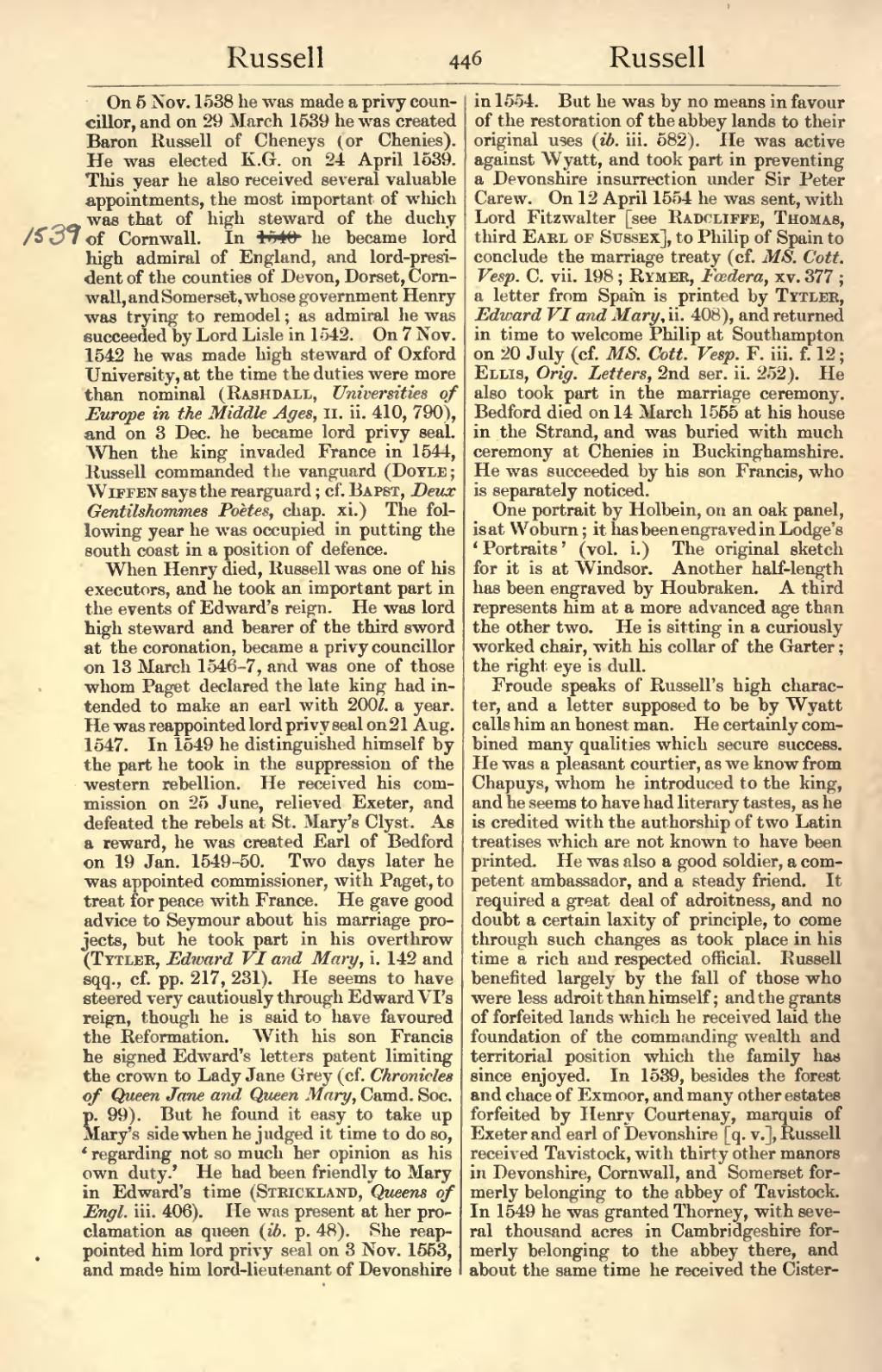On 5 Nov. 1538 he was made a privy councillor, and on 29 March 1539 he was created Baron Russell of Cheneys (or Chenies). He was elected K.G. on 24 April 1539. This year he also received several valuable appointments, the most important of which was that of high steward of the duchy of Cornwall. In 1540 he became lord high admiral of England, and lord-president of the counties of Devon, Dorset, Cornwall, and Somerset, whose government Henry was trying to remodel; as admiral he was succeeded by Lord Lisle in 1542. On 7 Nov. 1542 he was made high steward of Oxford University, at the time the duties were more than nominal (Rashdall, Universities of Europe in the Middle Ages, II. ii. 410, 790), and on 3 Dec. he became lord privy seal. When the king invaded France in 1544, Russell commanded the vanguard (Doyle; Wiffen says the rearguard; cf. Bapst, Deux Gentilshommes Poètes, chap. xi.) The following year he was occupied in putting the south coast in a position of defence.
When Henry died, Russell was one of his executors, and he took an important part in the events of Edward's reign. He was lord high steward and bearer of the third sword at the coronation, became a privy councillor on 13 March 1546–7, and was one of those whom Paget declared the late king had intended to make an earl with 200l. a year. He was reappointed lord privy seal on 21 Aug. 1547. He gave good advice to Seymour about his marriage projects, but he took part in his overthrow (Tytler, Edward VI and Mary, i. 142 and sqq., cf. pp. 217, 231). In 1549 he distinguished himself by the part he took in the suppression of the western rebellion. He received his commission on 25 June, relieved Exeter, and defeated the rebels at St. Mary's Clyst. As a reward, he was created Earl of Bedford on 19 Jan. 1549–50. Two days later he was appointed commissioner, with Paget, to treat for peace with France. He seems to have steered very cautiously through Edward VI's reign, though he is said to have favoured the Reformation. With his son Francis he signed Edward's letters patent limiting the crown to Lady Jane Grey (cf. Chronicles of Queen Jane and Queen Mary, Camd. Soc. p. 99). But he found it easy to take up Mary's side when he judged it time to do so, ‘regarding not so much her opinion as his own duty.’ He had been friendly to Mary in Edward's time (Strickland, Queens of Engl. iii. 406). He was present at her proclamation as queen (ib. p. 48). She reappointed him lord privy seal on 3 Nov. 1553, and made him lord-lieutenant of Devonshire in 1554. But he was by no means in favour of the restoration of the abbey lands to their original uses (ib. iii. 582). He was active against Wyatt, and took part in preventing a Devonshire insurrection under Sir Peter Carew. On 12 April 1554 he was sent, with Lord Fitzwalter [see Radcliffe, Thomas, third Earl of Sussex], to Philip of Spain to conclude the marriage treaty (cf. MS. Cott. Vesp. C. vii. 198; Rymer, Fœdera, xv. 377; a letter from Spain is printed by Tytler, Edward VI and Mary, ii. 408), and returned in time to welcome Philip at Southampton on 20 July (cf. MS. Cott. Vesp. F. iii. f. 12; Ellis, Orig. Letters, 2nd ser. ii. 252). He also took part in the marriage ceremony. Bedford died on 14 March 1555 at his house in the Strand, and was buried with much ceremony at Chenies in Buckinghamshire. He was succeeded by his son Francis [q. v.], who is separately noticed.
One portrait by Holbein, on an oak panel, is at Woburn; it has been engraved in Lodge's ‘Portraits’ (vol. i.) The original sketch for it is at Windsor. Another half-length has been engraved by Houbraken. A third represents him at a more advanced age than the other two. He is sitting in a curiously worked chair, with his collar of the Garter; the right eye is dull.
Froude speaks of Russell's high character, and a letter supposed to be by Wyatt calls him an honest man. He certainly combined many qualities which secure success. He was a pleasant courtier, as we know from Chapuys, whom he introduced to the king, and he seems to have had literary tastes, as he is credited with the authorship of two Latin treatises which are not known to have been printed. He was also a good soldier, a competent ambassador, and a steady friend. It required a great deal of adroitness, and no doubt a certain laxity of principle, to come through such changes as took place in his time a rich and respected official. Russell benefited largely by the fall of those who were less adroit than himself; and the grants of forfeited lands which he received laid the foundation of the commanding wealth and territorial position which the family has since enjoyed. In 1539, besides the forest and chace of Exmoor, and many other estates forfeited by Henry Courtenay, marquis of Exeter and earl of Devonshire [q. v.], Russell received Tavistock, with thirty other manors in Devonshire, Cornwall, and Somerset formerly belonging to the abbey of Tavistock. In 1549 he was granted Thorney, with several thousand acres in Cambridgeshire formerly belonging to the abbey there, and about the same time he received the Cister-
